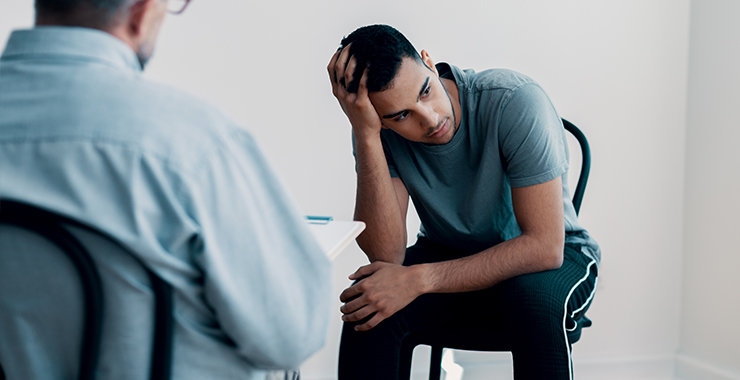Cognitive behavioral therapy (CBT) is an empirically supported first-line intervention for anxiety disorders. CBT refers to a family of techniques designed to address maladaptive thoughts and behaviors that maintain anxiety over time. Several individual CBT protocols have been developed for individual presentations of anxiety.
Anxiety is the most common mental health condition in the United States, but according to the Anxiety and Depression Association of America, only about 37 percent of people receive treatment.
Anxiety has no quick solution. While medications are sometimes necessary and part of a good treatment plan, telehealth for anxiety can also help you overcome anxiety. It can help you discover the root cause of your anxiety and the steps you can take to combat it. One treatment option that has been shown to be effective is cognitive behavioral therapy (CBT).
What is CBT?
CBT is a type of therapy that works with negative thought patterns or behaviors in an effort to recognize and restructure them. In other words, CBT can help you change the way you approach a situation.
For example, if you are about to start a new job, you might feel several things:
Anxious. Because it’s a new environment with new coworkers and processes, you may feel anxious. You might think, “I’ll never be able to figure it out” and consider calling in sick on the first day.
Neutral. You may feel neutral because you have had other jobs in the past. After all, work is just work. You might think, “As soon as the day is over, I’ll go out to dinner.” You could leave work and go shopping, focusing on the rest of the night.
Enthusiastic. As you begin a new adventure and face new challenges, you may feel excited. You might think, “I can’t wait to collaborate on that new project.” You could go to the office and start introducing yourself to others.
Starting a new job can cause people to have different thoughts, feelings, and behaviors. All of these differences depend on the personal attitudes, beliefs, and assumptions we have about our circumstances.
Cognitive-behavioral therapy (CBT) for anxiety
Cognitive behavioral therapy (CBT) is the most widely used therapy for anxiety disorders. Research has shown it to be effective in treating panic disorder, phobias, social anxiety disorder, and generalized anxiety disorder, among many other conditions.
CBT addresses negative patterns and distortions in the way we look at the world and ourselves. As the name suggests, this involves two main components:
- Cognitive therapy examines how negative thoughts or cognitions contribute to anxiety.
- Behavioral therapy examines how you behave and react in situations that trigger anxiety.
The basic premise of CBT is that our thoughts, not external events, affect the way we feel. In other words, it is not the situation you are in that determines how you feel, but your perception of the situation.
For example, imagine that you have just been invited to a big party. Consider three different ways of thinking about the invitation and how those thoughts would affect your emotions.
CBT techniques for anxiety
CBT professionals use some common techniques to help you manage anxiety and change your behavior. Cognitive restructuring, or reframing: involves carefully analyzing negative thought patterns. Maybe you tend to:
- Overgeneralize
- Assume the worst will happen
- Give too much importance to minor details
Your therapist will ask you about your thought processes in certain situations so that you can identify negative patterns. Once you are aware of them, you can learn to reframe those thoughts to be more positive and productive.
Challenging thinking
The thinking challenge is to consider things from multiple angles, using real evidence from your life. The thinking challenge can help you consider things from a more objective perspective, rather than simply assuming that your thoughts are the facts or truth.
Education about cognitive distortions can help a person identify when a cognitive distortion appears in their thoughts, allowing them to work to correct unhelpful thoughts and turn them into thoughts that are more balanced and objective.
Behavioral activation
If anxiety prevents you from doing a certain activity, you can schedule it by writing it on your calendar. This sets a plan, so you don’t keep worrying about it.
For example, if you’re worried about your kids getting sick on the playground, you can schedule a park date with a friend. This will encourage you to move forward and confront the situation, armed with the skills you work on in CBT.
Diary: Journaling, also called a thought journal, helps you get in touch with and become aware of your thoughts and feelings. It can also help clarify and organize your thoughts.
You could make lists of your negative thoughts and the positive ones you can exchange them with. Your therapist may encourage you to write down new skills and behaviors you work on between therapy sessions.
Behavioral experiments: These are commonly used when you are experiencing catastrophic thoughts, which is when you assume the worst is going to happen.
Relaxation techniques
Relaxation techniques reduce stress and allow you to think more clearly. In turn, these can help you regain control of a situation. These techniques could include:
- Deep breathing exercises
- Progressive muscle relaxation
- Meditation
Carry: Anxiety can be challenging, but the good news is that there are steps you can take to overcome it. CBT is a way to change your negative thought patterns to positively affect how you respond to situations.
By finding a talk therapy center experienced in CBT, you will be able to take steps to manage your mental health. You can then take the skills you learn from CBT and apply them to future situations.


